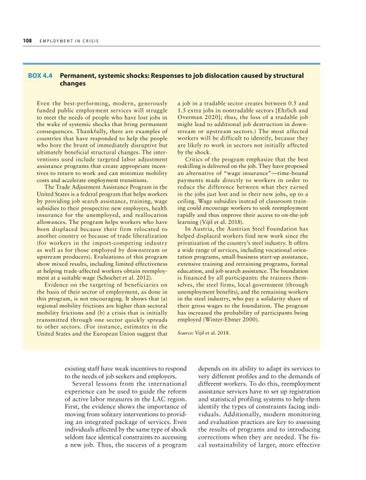108 E m p l o y m e n t
in Crisis
BOX 4.4 Permanent, systemic shocks: Responses to job dislocation caused by structural changes Even the best-performing, modern, generously funded public employment services will struggle to meet the needs of people who have lost jobs in the wake of systemic shocks that bring permanent consequences. Thankfully, there are examples of countries that have responded to help the people who bore the brunt of immediately disruptive but ultimately beneficial structural changes. The interventions used include targeted labor adjustment assistance programs that create appropriate incentives to return to work and can minimize mobility costs and accelerate employment transitions. The Trade Adjustment Assistance Program in the United States is a federal program that helps workers by providing job search assistance, training, wage subsidies to their prospective new employers, health insurance for the unemployed, and reallocation allowances. The program helps workers who have been displaced because their firm relocated to another country or because of trade liberalization (for workers in the import-competing industry as well as for those employed by downstream or upstream producers). Evaluations of this program show mixed results, including limited effectiveness at helping trade-affected workers obtain reemployment at a suitable wage (Schochet et al. 2012). Evidence on the targeting of beneficiaries on the basis of their sector of employment, as done in this program, is not encouraging. It shows that (a) regional mobility frictions are higher than sectoral mobility frictions and (b) a crisis that is initially transmitted through one sector quickly spreads to other sectors. (For instance, estimates in the United States and the European Union suggest that
a job in a tradable sector creates between 0.5 and 1.5 extra jobs in nontradable sectors [Ehrlich and Overman 2020]; thus, the loss of a tradable job might lead to additional job destruction in downstream or upstream sectors.) The most affected workers will be difficult to identify, because they are likely to work in sectors not initially affected by the shock. Critics of the program emphasize that the best reskilling is delivered on the job. They have proposed an alternative of “wage insurance”—time-bound payments made directly to workers in order to reduce the difference between what they earned in the jobs just lost and in their new jobs, up to a ceiling. Wage subsidies instead of classroom training could encourage workers to seek reemployment rapidly and thus improve their access to on-the-job learning (Vijil et al. 2018). In Austria, the Austrian Steel Foundation has helped displaced workers find new work since the privatization of the country’s steel industry. It offers a wide range of services, including vocational orientation programs, small-business start-up assistance, extensive training and retraining programs, formal education, and job search assistance. The foundation is financed by all participants: the trainees themselves, the steel firms, local government (through unemployment benefits), and the remaining workers in the steel industry, who pay a solidarity share of their gross wages to the foundation. The program has increased the probability of participants being employed (Winter-Ebmer 2000). Source: Vijil et al. 2018.
existing staff have weak incentives to respond to the needs of job seekers and employers. Several lessons from the international experience can be used to guide the reform of active labor measures in the LAC region. First, the evidence shows the importance of moving from solitary interventions to providing an integrated package of services. Even individuals affected by the same type of shock seldom face identical constraints to accessing a new job. Thus, the success of a program
depends on its ability to adapt its services to very different profiles and to the demands of different workers. To do this, reemployment assistance services have to set up registration and statistical profiling systems to help them identify the types of constraints facing individuals. Additionally, modern monitoring and evaluation practices are key to assessing the results of programs and to introducing corrections when they are needed. The fiscal sustainability of larger, more effective

